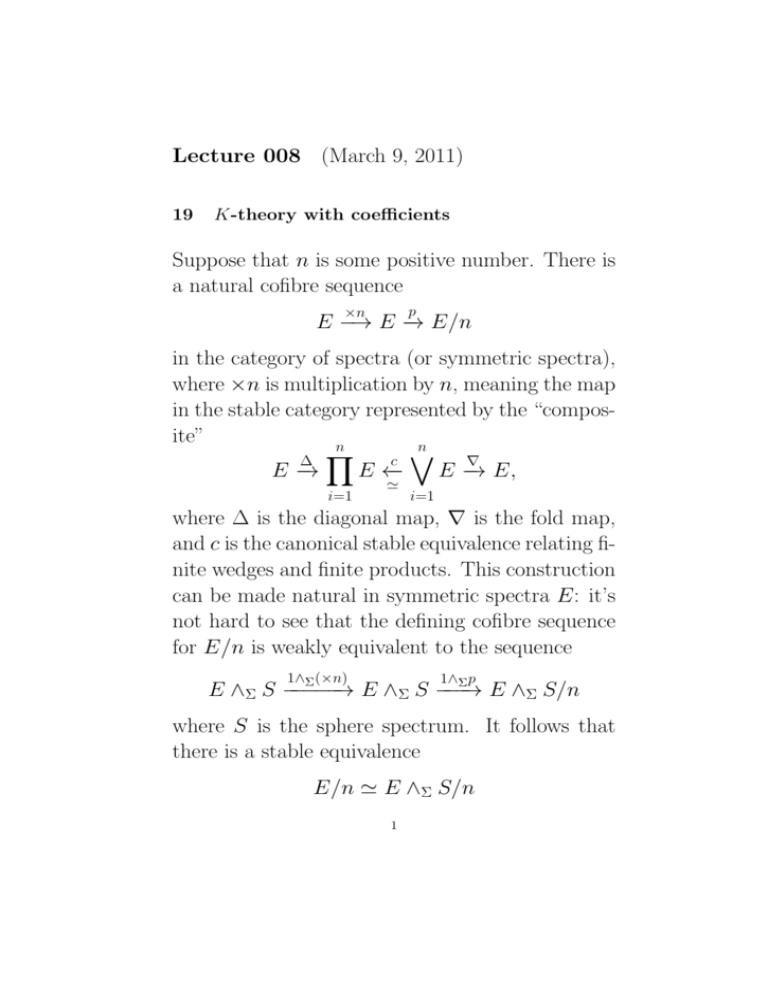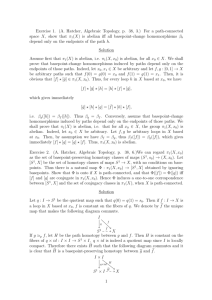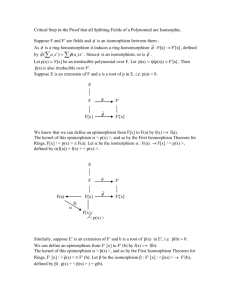Lecture 008 (March 9, 2011) Suppose that n is some positive
advertisement

Lecture 008 (March 9, 2011) 19 K-theory with coefficients Suppose that n is some positive number. There is a natural cofibre sequence p ×n E −→ E → − E/n in the category of spectra (or symmetric spectra), where ×n is multiplication by n, meaning the map in the stable category represented by the “composite” n n Y _ ∆ c ∇ E− → E← − E− → E, i=1 ' i=1 where ∆ is the diagonal map, ∇ is the fold map, and c is the canonical stable equivalence relating finite wedges and finite products. This construction can be made natural in symmetric spectra E: it’s not hard to see that the defining cofibre sequence for E/n is weakly equivalent to the sequence 1∧ (×n) 1∧ p Σ Σ E ∧Σ S −−− −−→ E ∧Σ S −−− → E ∧Σ S/n where S is the sphere spectrum. It follows that there is a stable equivalence E/n ' E ∧Σ S/n 1 so that E/n may be constructed from E by smashing with the “Moore spectrum” S/n. Alternatively, let P (n) be the homotopy cofibre of the map ×n : S 1 → S 1. Then the comparison of homotopy fibre sequences / Ω(E/n) hom∗(P (n), E))[1] / E ×n / ' E ' hom∗(S 1, E)[1](×n)∗/ hom∗(S 1, E)[1] implies that there is a stable equivalence Ω(E/n) ' hom∗(P (n), E)[1], (after making E fibrant, at least), so that there are stable equivalences E/n ' Ω(E/n)[1] ' hom∗(P (n), E)[2]. (1) Any cofibre sequence in symmetric spectra is a fibre sequence, and so any cofibre sequence induces a fibre sequence in associated stably fibrant models, and hence induces a long exact sequence in stable homotopy groups for symmetric spectra, as defined above. It follows in particular that there is a natural long exact sequence ×n ∂ ∂ · · · → πn+1(E/n) → − πn(E) −→ πn(E) → πn(E/n) → − ... 2 and corresponding natural short exact sequences 0 → πn(E)⊗Z/n → πn(E/n) → Tor(Z/n, πn−1(E)) → 0. Thus, if E is connective then E/n is connective. Smashing with a fixed symmetric spectrum preserves stable cofibre sequences (in a derived sense), and therefore also preserves stable fibre sequences. Thus if E acts on a fibre sequence F1 → F2 → F3 in the sense that there is a commutative diagram E ∧Σ F1 / / E ∧Σ F2 F1 / E ∧Σ F3 / F2 F3 then the induced comparison E ∧Σ F1 ∧Σ S/n F1 ∧Σ S/n / E ∧Σ F2 ∧Σ S/n / F2 ∧Σ S/n / E ∧Σ F3 ∧Σ S/n / F3 ∧Σ S/n gives a fibre sequence F1/n → F2/n → F3/n with an action by E. Suppose that M is an exact category. Then K(M)/n is the mod n K-theory spectrum, and it is standard to write Kp(M, Z/n) = πp(K(M)/n). 3 Thus, for a scheme (respectively Noetherian scheme) X we write Kp(X, Z/n) = πp(K(X)/n) for the mod n K-groups of X and Kp0 (X, Z/n) = πp(K 0(X)/n) for the mod n K 0-groups of X. Example: Bott elements 1) Suppose that k is a field with char(k) not dividing n. Suppose that k contains a primitive nth root of unity ξ. The composite Bk ∗ → BGl(k) → K(k)0 (which is a π1-isomorphism) induces a map of spectra Σ∞Bk ∗ → K(k) The induced map π2hom∗(P (n), Σ∞Bk ∗)[2] →π2hom∗(P (n), K(k))[2] = K2(k, Z/n) coincides with the map π0hom∗(P (n), Σ∞Bk ∗) → π0hom∗(P (n), K(k)). 4 Then the composite π0hom∗(P (n), Bk ∗) / π0hom∗(P (n), Σ∞Bk ∗) π0hom∗(P (n), K(k)) defines a map φ : nk ∗ → K2(k, Z/n) which splits the canonical surjection K2(k, Z/n) nk ∗. (2) An element β ∈ K2(k, Z/n) which maps to ξ under the surjection (2) is called a Bott element. Write β = φ(ξ), and let this be a fixed choice of Bott element in all that follows (there are others, given by other primitive roots). 2) If k is algebraically closed, then K2(k) is uniquely divisible [3] so that K2(k, Z/n) ∼ = µn (nth roots of unity) with generator β. More generally, Suslin’s rigidity theorem [4], [5] (and a comparison with KU/`) implies that multiplication by the Bott element induces a map β K(k)/`(k) → − Ω2K/`(k) which induces an isomorphism in stable homotopy 5 groups πj for j ≥ 0, so there are isomorphisms K2k (k, Z/n) ∼ = µ⊗k , n for k > 0 and K2r+1(k, Z/n) = 0 for all r ≥ 0. The bad news is that the mod n K-theory spectrum K(X)/n may not have a ring spectrum structure in general, because the Moore spectrum S/n may not have a ring spectrum structure — see [6, A.6]. In all that follows, let ` be a prime which is distinct from the characteristic of k and let n = `ν , where ν ≥ 2 if ` = 3 and ν ≥ 4 if ` = 2 (these choices are made precisely so that S/n has a ring spectrum structure). Subject to these conditions, the ring structure on K∗(k, Z/n) is defined by tensor product in the obvious way, and there is a ring isomorphism Z/n[β] ∼ = K∗(k, Z/n). 3) Suppose now that k does not contain a primitive nth root of unity (n = `ν ), and let ξ ∈ k be a fixed choice of primitive root in the algebraic closure k. 6 The field k(ξ) is the splitting field for the polynomial X n − 1. Let f (x) be the irreducible polynomial for ξ (of degree d) and let G be the Galois group for k(ξ)/k. Then G acts on µn ⊂ k(ξ)∗. If ζ is a root of the polynomial f (X) (hence also a primitive nth root of unity), then ζ ∈ K2(k(ζ), Z/n) via the map φ : nk(ζ)∗ → K2(k(ζ), Z/n) described above. The product element Y β∗ = ζ ∈ K2d(k(ξ), Z/n) f (ζ)=0 is G-invariant, and is non-zero since the element β d 6= 0 in K2d(k, Z/n), and β∗ maps to a non-zero multiple of β d. Finally, consider the base change morphism i∗ : K∗(k, Z/n) → K∗(k(ξ), Z/n) as well as the transfer i∗ : K∗(k(ξ), Z/n) → K∗(k, Z/n). One can show at the exact category level (exercise) that the map i∗i∗ : K∗(k, Z/n) → K∗(k, Z/n) 7 is multiplication by the degree d, and that the composite i∗i∗ : K∗(k(ξ), Z/n) → K∗(k(ξ), Z/n) P is multiplication by the norm element N = g∈G g in the evident Galois module structure. The inverse image i∗ takes values in the G-invariants K∗(k(ξ), Z/n)G, and the i∗i∗ restricts to the map K∗(k(ξ), Z/n)G → K∗(k(ξ), Z/n)G which is multiplication by the degree d. The element [d] is a unit of Z/`r for all r, since d|(`n − 1) so that ` does not divide d. It follows that transfer and base change define an isomorphism K∗(k, Z/n) ∼ = K∗(k(ξ), Z/n)G, so that β d ∈ K2d(k, Z/n). In other words, some power of the Bott element is always in the K-theory of the base field k, under the assumptions that we have made on the coefficients. 8 20 K-theory with finite coefficients, and homology Suppose that ` is a prime number. Lemma 20.1. Suppose that X is a simply connected space. Then the homotopy groups of X are uniquely `-divisible if and only if H̃∗(X, Z/`) = 0 Here (and as usual), H̃∗(X, Z/`) is the reduced mod ` homology of X: it is the kernel of the map H∗(X, Z/`) → H∗(∗, Z/`). The requirement that H̃∗(X, Z/`) = 0 is equivalent to saying that X has the mod ` homology of a point. Proof. Suppose that A is a uniquely `-divisible abelian group. Then H1(BA) ∼ = A is uniquely `-divisible, so that H1(BA, Z/`) = 0. Suppose that Hi(BA, Z/`) = 0 for 1 ≤ i ≤ r. Then multiplication by ` on BA is given by a composite ∇ ∆ BA − → BA×` − → BA and this composite is an isomorphism of simplicial abelian groups. The induced map (×`)∗ Hr+1(BA, Z/`) −−−→ Hr+1(BA, Z/`) 9 is multiplication by ` by a Künneth formula argument, and this composite is an isomorphism. The homology groups H̃∗(X, Z/`) for any space X are `2-torsion, so it follows that Hr+1(BA, Z/`) = 0. Thus, inductively, H̃∗(BA, Z/`) = 0. It follows from a standard Serre spectral sequence argument that H̃∗(K(A, n), Z/`) = 0 for all n ≥ 1. Suppose that X is a simply connected space with uniquely `-divisible homotopy groups. The Postnikov sections PnX have the same property, and there are fibre sequences K(πn(X), n) → PnX → Pn−1X. We know that H̃∗(K(πn(X), n), Z/`) = 0. Thus an inductive Serre spectral sequence argument shows that H̃∗(Pn(X), Z/`) = 0 for all n ≥ 2. A Serre spectral sequence argument also shows that the map π : X → PnX induces isomorphisms H̃k (X, Z/`) ∼ = H̃k (Pn(X), Z/`) = 0 for 0 ≤ k ≤ n. By taking n sufficiently large, we see that H̃k (X, Z/`) = 0 10 for all k ≥ 0. Suppose, conversely, that H̃∗(X, Z/`) = 0, and let πk (X) be the bottom non-vanishing homotopy group. Then πk (X) = Hk (X) by the Hurewicz Theorem, and Hk (X) is uniquely `-divisible since H̃∗(X, Z/`) = 0. There is a fibre sequence F → X → K(πk (X), k) where F is k-connected and k ≥ 2. Then H̃∗(K(πk (X), k), Z/`) = 0 by the first paragraph, so a Serre spectral sequence argument shows that H̃∗(F, Z/`) = 0. Then πk+1(F ) ∼ = πk+1(X) is uniquely `-divisible. Inductively, all homotopy groups of X are uniquely `-divisible. Recall that the fundamental groupoid π(Y ), for a Kan complex Y , can be constructed to have the vertices of Y as objects and naive homotopy classes of paths ∆1 → Y rel. end points as morphisms. The composition laws π(Y )(x, y) × π(Y )(y, z) → π(Y )(x, z) are defined by 2-simplex fill-ins. There is a canonical map π : Y → B(π(Y )) which is the identity 11 on vertices, and takes an n-simplex σ : ∆n → X to the string of morphisms σ(0) → σ(1) → · · · → σ(n) which are determined by the non-degenerate faces σ ∆1 ⊂ ∆n → − Y of σ. The induced group homomorphisms π1(Y, x) → π(Y )(x, x) are isomorphisms, by construction. If Z is another choice of Kan complex, then the groupoid homomorphism π(Y × Z) → π(Y ) × π(Z) is an isomorphism. Any homotopy Y × ∆1 → Z induces a homotopy h∗ : π(Y ) × 1 → π(Z), which is defined, as a natural transformation, by the images of the 1-simplices (y,1) h ∆1 −−→ Y × ∆1 → − Z. Now suppose that X is a connected H-space. We can suppose that X is a Kan complex — see the arguments in Section 12 (Lecture 005). 12 It follows that from the paragraph above that the space B(π(X)) is a connected H-space, and that the canonical map π : X → B(π(X)) is multiplicative. The map π is also surjective (actually an isomorphism) on fundamental groups, so that as in the proof of Lemma 12.1 the fundamental groupoid of B(π(X)) (which is π(X)) acts trivially on the homology H∗(F, Z/`) of the homotopy fibres F of the map π, and so the corresponding Serre spectral sequence has the standard form E2p,q = Hp(B(π(X)),Hq (F, Z/`)) ⇒ Hp+q (X, Z/`). (3) Recall that the homotopy fibre F of the map π : X → B(π(X)) is the universal cover of X. Lemma 20.2. Suppose that X is a connected H-space. Then the homotopy groups of X are uniquely `-divisible if and only if H̃∗(X, Z/`) = 0. Proof. Suppose that all of the homotopy groups of X are uniquely `-divisible. Then the homotopy groups of the universal cover F of X are uniquely `-divisible, so that H̃∗(F, Z/`) = 0 by Lemma 20.1. An argument using the spectral sequence 13 (3) then shows that the map H∗(X, Z/`) → H∗(B(π(X)), Z/`) is an isomorphism. But then there is a weak equivalence B(π(X)) ' B(π1(X)) and π1(X) is a uniquely `-divisible abelian group so that H̃∗(B(π1(X)), Z/`) = 0 by the proof of Lemma 20.1. Suppose conversely that H̃∗(X, Z/`) = 0. Then π1(X) ∼ = H1(X) is a uniquely `-divisible abelian group, so that H̃∗(B(π(X)), Z/`) = 0. From the spectral sequence (3), we then conclude that H̃∗(F, Z/`) = 0. But this means that all of the homotopy groups of the universal cover F of X are uniquely `-divisible, by Lemma 20.1. Thus, all of the homotopy groups of X are uniquely `divisible. Lemma 20.3. Suppose that f : A → A0 is a homomorphism of abelian groups. Then f induces an isomorphism ∼ = f∗ : H∗(BA, Z/`) − → H∗(BA0, Z/`) if and only if the groups ker(f ) and cok(f ) are uniquely `-divisible. 14 Proof. If ker(f ) and cok(f ) are uniquely `-divisible, then the maps BA B im(f ) and B im(f ) ,→ BA0 induce H̃∗( , Z/`)-isomorphisms, by Serre spectral sequence arguments, since H̃∗(B ker(f ), Z/`) ∼ = H̃∗(B cok(f ), Z/`) = 0. Conversely, if the map f∗ : H∗(BA, Z/`) → H∗(BA0, Z/`) is an isomorphism, then the map f∗ : H∗(B 3A, Z/`) → H∗(B 3A0, Z/`) is an isomorphism, by an iterated Künneth formula argument. The homotopy fibre F of the map f∗ : B 3A → B 3A0 is a simply connected space with H̃∗(F, Z/`) = 0. Lemma 20.1 implies that the homotopy groups of F are uniquely `divisible. The non-trivial homotopy groups of F are π3(F ) = ker(f ) and π2(F ) = cok(f ), so that ker(f ) and cok(f ) are uniquely `-divisible. Theorem 20.4. Suppose that f : O → O0 is a local homomorphism of local rings. Then the induced map f∗ : K(O)/` → K(O0)/` 15 is a stable equivalence if and only if the map f∗ : H∗(BGl(O), Z/`) → H∗(BGl(O0), Z/`) is an isomorphism. The requirement that f : O → O0 is a local homomorphism means that f (M) ⊂ M0, where M and M0 are the respective maximal ideals. Morphisms of this type include all residue maps O → O/M, all morphisms k → O where k is a field, and all field homomorphisms k → L. Proof. Let F be the homotopy fibre of the map K(O) → K(O0) in the stable category. Then F is a connective spectrum. The map K(O)0 → K(O0)0 is an isomorphism in π0 (since K0(O) ∼ = K0(O0) ∼ = Z), so there is a fibre sequence f∗ F 0 → BGl(O)+ − → BGl(O0)+ by the Q = + theorem (Theorem 11.1). The standard inclusion R∗ → Gl(R) of groups (R∗ is units in R) induces a natural splitting det BR∗ → BGl(R) −→ BR∗ 16 of the determinant homomorphism. Thus, if the natural homomorphism K1(R) → R∗ is an isomorphism, then the long exact sequence for resulting fibre sequence BSl(R)+ → BGl(R)+ → BR∗ breaks up into short exact sequences 0 → πn(BSl(R)+) → πn(BGl(R)+) → πn(BR∗) → 0 which are split by the induced map πn(BR∗) → πn(BGl(R)+). It follows that the composite ⊕ BSl(R)+×BR∗ → BGl(R)+×BGl(R)+ − → BGl(R)+ is a weak equivalence in all such cases. It follows that there is a homotopy commutative diagram BSl(O)+ × BO∗ ' / BGl(O)+ f∗ BSl(O0)+ × BO0∗ / ' BGl(O0)+ in which the vertical maps are weak equivalences. It also follows that the map f∗ : BGl(O) → BGl(O0) is an H∗( , Z/`)-isomorphism if and only if the maps f∗ BSl(O)+ − → BSl(O0)+ 17 and BO∗ → BO0∗ are H∗( , Z/`)-isomorphisms. The map BSl(O)+ → BSl(O0)+ is the map of spaces in level 0 of the 1-connected covers K(O)(1) → K(O0)(1) of the respective K-theory spectra. Let E be the homotopy fibre of this map. Then the space E 0 is a connected H-space, and so by Lemma 20.2 the homotopy groups of E 0 are uniquely `-divisible if and only if H̃∗(E 0, Z/`) = 0. But this is true if and only if the map f∗ : BSl(O)+ → BSl(O0)+ is an H∗( , Z/`)-isomorphism, by a Serre spectral sequence argument. It follows that the map f∗ BGl(O) − → BGl(O0) is an H∗( , Z/`)-isomorphism if and only if the groups π∗(E), and the kernel and cokernel of the map f∗ : O∗ → O0∗ are all uniquely `-divisible. The homotopy groups of the fibre F 0 of the map 18 K(O)0 → K(O0)0 are of the form ∗ 0∗ if j = 0, cok(O → O ) πj (F 0) = π1(E 0) ⊕ ker(O∗ → O0∗) if j = 1, and πj (E 0) if j > 1. It follows that the homotopy groups of F 0 are all uniquely `-divisible if and only if the map f∗ : BGl(O) → BGl(O0) is an H∗( , Z/`)-isomorphism. But this means that f∗ is an H∗( , Z/`)-isomorphism if and only if the map f∗ : K(O)/` → K(O0)/` is a stable equivalence, because F/` is stably trivial if and only if the homotopy groups of F 0, are uniquely `-divisible. The n-connected cover E(n) of a spectrum E is the fibre of the nth Postnikov section E → Pn(E). A construction of the functor E 7→ Pn(E) is given in [2, Sec. 4.7], but the construction can also be fudged by playing with the diagrams Pn+k E k Pn+k σ∗ / k+1 Pn+k ΩE O Pn+k Ωπn+k+1 / k+1 Pn+k ΩPn+k+1 E O πn+k ΩE k+1 19 πn+k ' Ωπn+k+1 / ΩPn+k+1E k+1 Here, πr : Z → Pr Z denotes the standard map taking values in the Postnikov section Pr Z for a simplicial set Z. References [1] William Dwyer, Eric Friedlander, Victor Snaith, and Robert Thomason. Algebraic Ktheory eventually surjects onto topological K-theory. Invent. Math., 66(3):481–491, 1982. [2] J. F. Jardine. Generalized Étale Cohomology Theories, volume 146 of Progress in Mathematics. Birkhäuser Verlag, Basel, 1997. [3] John Milnor. Introduction to algebraic K-theory. Princeton University Press, Princeton, N.J., 1971. Annals of Mathematics Studies, No. 72. [4] A. Suslin. On the K-theory of algebraically closed fields. Invent. Math., 73(2):241–245, 1983. [5] Andrei A. Suslin. On the K-theory of local fields. In Proceedings of the Luminy conference on algebraic K-theory (Luminy, 1983), volume 34, pages 301–318, 1984. [6] R. W. Thomason. Algebraic K-theory and étale cohomology. Ann. Sci. École Norm. Sup. (4), 18(3):437–552, 1985. 20








